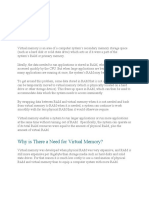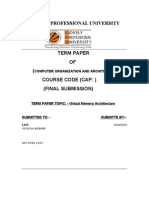0% found this document useful (0 votes)
5 views11 pagesVirtual Memory
Virtual Memory is a memory management technique that allows an operating system to use hard disk space to simulate additional RAM, enabling the running of larger programs and multitasking. It works by mapping virtual addresses to physical addresses and handling page faults when data is not in RAM. This feature is essential for modern computing, allowing users to operate multiple applications simultaneously without crashing their systems.
Uploaded by
vik300744Copyright
© © All Rights Reserved
We take content rights seriously. If you suspect this is your content, claim it here.
Available Formats
Download as PDF, TXT or read online on Scribd
0% found this document useful (0 votes)
5 views11 pagesVirtual Memory
Virtual Memory is a memory management technique that allows an operating system to use hard disk space to simulate additional RAM, enabling the running of larger programs and multitasking. It works by mapping virtual addresses to physical addresses and handling page faults when data is not in RAM. This feature is essential for modern computing, allowing users to operate multiple applications simultaneously without crashing their systems.
Uploaded by
vik300744Copyright
© © All Rights Reserved
We take content rights seriously. If you suspect this is your content, claim it here.
Available Formats
Download as PDF, TXT or read online on Scribd
/ 11































































